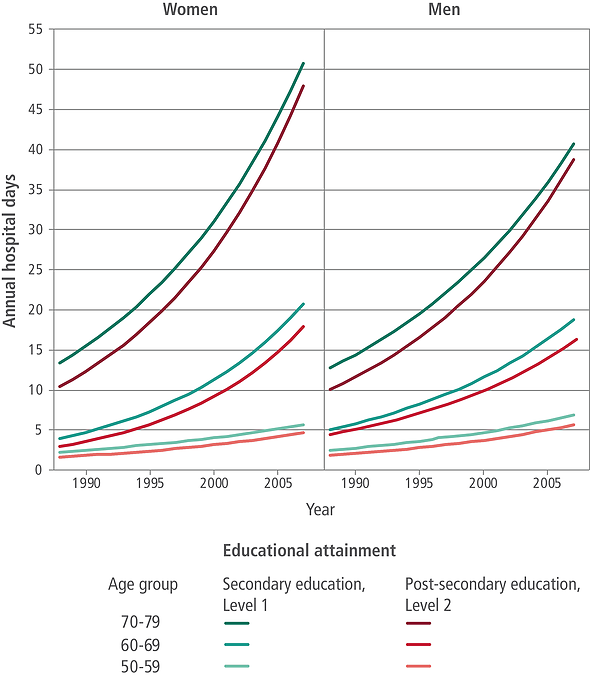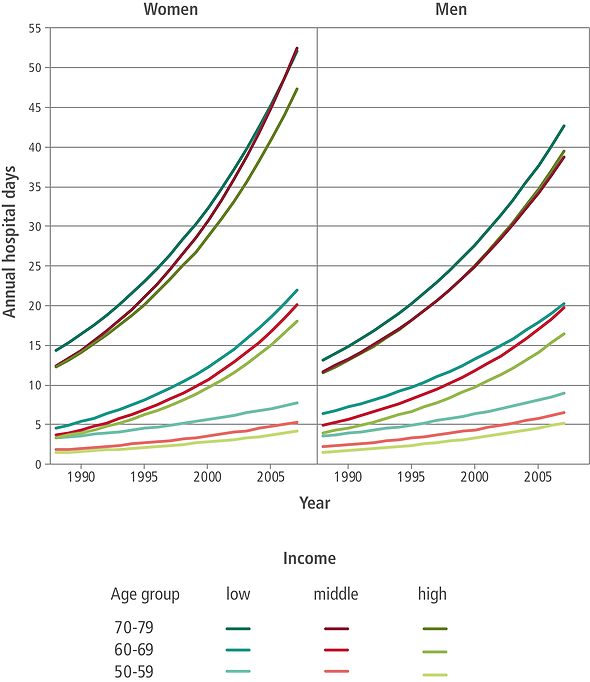July 17, 2018 | News | New Publication
Hospital stays: How does the influence of education and income change with age?
Individuals highly educated and on a high income spend less time in hospital. This is well known. But whether these differences grow or shrink with age is still disputed. A new study by the Max Planck Institute for Demographic Research now shows that both may hold.
(The following text is based on the original paper Changes in Socioeconomic Differences in Hospital Days With Age: Cumulative Disadvantage, Age-as-Leveler, or Both? by MPIDR researchers Yaoyue Hu and Mikko Myrskylä has as a German version with minor changes also been published in the issue 2/2018 of the demographic quarterly Demografische Forschung Aus Erster Hand.)
On the example of Finland, the Rostock demographers Yaoyue Hu and Mikko Myrskylä demonstrated that disparity convergence or divergence depends on the specific age group and on whether the given association is measured by relative or absolute differences. Together with Taina Leinone and Pekka Martikainen, both from the University of Helsinki, they evaluated data on 137,000 male and female Finns aged 50-79 in 1987, the start of the study.
The data is extensive and allowed the researchers to capture and evaluate the number of days spent in hospital by individuals over a period of 20 years (1987-2007). To bring out differing developments possible at various age groups, the researches evaluated the data separately for three age groups: a younger (50-69 years), middle (60-69 years) and an oldest (70-79 years) one.
As expected, the data showed that days spent in hospital sharply increase with age (cf. Figs.1 and 2). However, adults with a high socioeconomic status had fewer days in hospital than their counterparts of a lower status; this at any given time and age group.

Fig. 1: Absolute differences between the two education groups widen for the two younger age groups, but they narrowed for the oldest group, the 70- to 79-year-olds. © Source: Finnish registry data, 1988-2007, own calculations
The researchers evaluated this status using three different categories: Education, rated as "high" with completion of post-secondary education at minimum (roughly comparable to the German Abitur); household income, evaluated separately by age group and by gender and divided into lower, middle and upper thirds; and occupational group by unskilled workers, skilled workers, and white-collar workers. A fourth group included the remainder, such as farmers, the self-employed or students.
In 1987, the start of the study, the number of hospital days for the socially and economically better off had already 10-60 percent fewer hospital days than their counterparts with a relatively low social status and a low household income (see Figs. 1 and 2).
But in what direction would these differences develop over the 20 years following the start of the study, i.e., up to 2007? Would they continue to grow because the negative effects of a low social status accumulate over life? Or would they decline because differences in health behaviors and psychosocial factors converge again at older ages?

Fig. 2: Absolute differences between the various income groups also widen for the two younger age groups, but for hospital days they converge for the oldest group, the 70- to 79-year-olds. © Source: Finnish registry data, 1988-2007, own calculations
Yaoyue Hu and her colleagues find evidence for both hypotheses: With increasing age, relative differences in hospital days remained largely unchanged between most of the status and age groups. They declined, however, between the lowest and highest income groups for men aged 50-69 and between the lowest and middle income groups for women aged 50-59. There was also convergence between different occupational groups for the oldest group of women.
A different picture emerges, however, when looking at absolute rather than relative differences. Of the women aged 60-69, for example, the highly educated spent around 3 days in hospital in 1988; this compares to 4 day for those with a lower education. The absolute difference thus was 1 day, but the relative difference was around 25 percent.
In 2007, the lower-educated women had already spent more than 20 days in hospital, compared to an average of only 17 days for their higher educated counterparts. The absolute difference had thus increased to 3 days, but in relative terms time spent in hospital was a mere 15 percent shorter for the better-educated. Thus, while the absolute difference had roughly tripled, the relative difference had decreased significantly.
Men and women in the two younger age groups (50-59, 60-69) showed similar developments: The absolute differences between the high and low income groups, the high and low education groups, and the occupational groups widened throughout. Only the 70- to 79-year-olds developed in the opposite direction: Both relative and absolute differences narrowed with rising age.
Co-author of the scientific study:
Yaoyue Hu
More Information
Original Article: Changes in Socioeconomic Differences in Hospital Days With Age: Cumulative Disadvantage, Age-as-Leveler, or Both? Yaoyue Hu, PhD Taina Leinonen, PhD Mikko Myrskylä, PhD Pekka Martikainen, PhD , The Journals of Gerontology: Series B, gbx161, https://doi.org/10.1093/geronb/gbx161